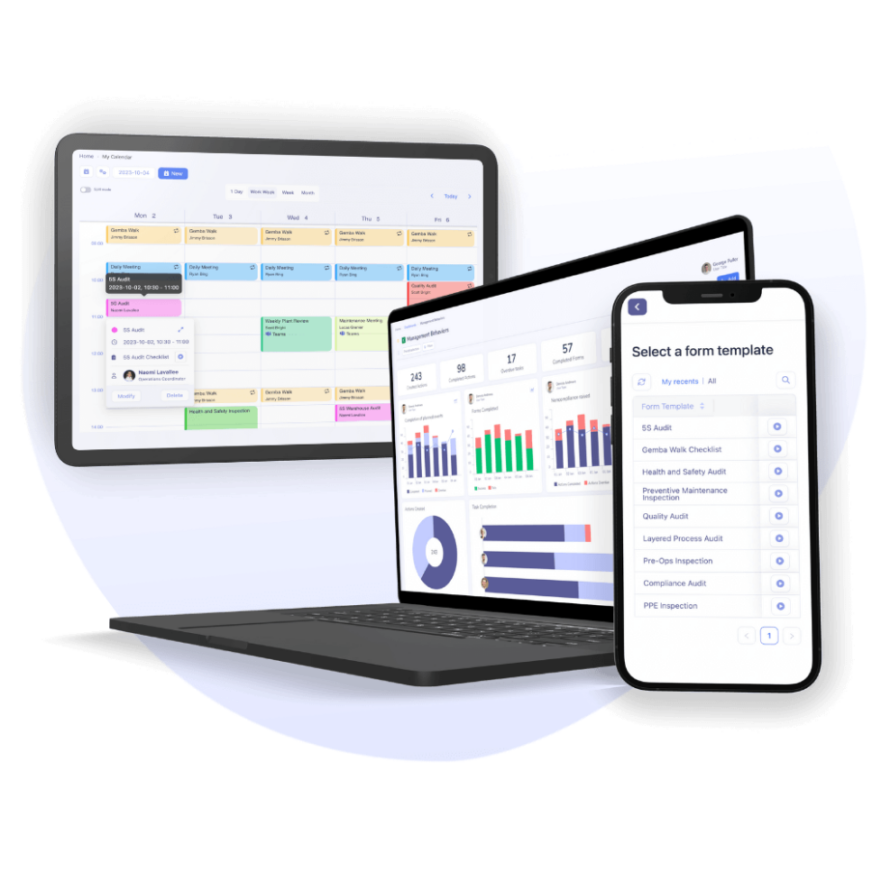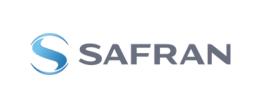What Is Lean Daily Management?

| Audience: | Manufacturing Managers, Healthcare Administrators, Operational Excellence and Lean Management Practitioners, HR Coordinators, Organizational Leaders |
| Last updated: | July 26, 2025 |
| Read time: | 14 min |
- Brings structure to daily work: With routines like Leader Standard Work, daily huddles, and visual boards, LDM turns chaotic operations into predictable, efficient workflows.
- Fixes problems at the source: Teams solve issues where they happen (at the Gemba), using tools like PDCA cycles and root cause analysis for lasting improvements.
- Builds a culture of continuous improvement: From reducing process variation to improving safety and communication, LDM creates habits that drive better performance—and better results.
Defining Lean Daily Management (LDM meaning)
Lean Daily Management (LDM) is a systematic strategy for building Lean habits and managing continuous improvement and daily operations in the workplace. It involves multiple aspects, such as Leader Standard Work and Lean management routines, visual management boards, daily accountability, and problem-solving where the work happens (Gemba). LDM improves efficiency, quality, and communication by tackling day-to-day issues and deviations. It is precious in sectors like manufacturing and healthcare.
Lean Daily Management Principles
LDM focuses on processes rather than people. Its goal is to ensure a standard procedure for problem-solving directly at the Gemba – where value is created. This method challenges existing processes by pinpointing deviations and nonconformances against set performance goals. For instance, it may put the PDCA cycle to good use to achieve its goal.
Moreover, LDM is instrumental in establishing and maintaining rigorous management standards for continual improvement. A pivotal component of LDM is the thorough pursuit of waste elimination and streamlining operations. Beyond process optimization, LDM also strengthens management skills and embeds Leader Standard Work practices into a Lean Leadership Culture.
Lean Daily Management Core Components
LDM encompasses three key components: Leader Standard Work, Daily Accountability Processes, and Visual Management.
Leader Standard Work
Leader Standard Work and Leadership Routines engage managers in active management and provide a structure for problem-solving through recurrent tasks such as process confirmation through audits and inspections (e.g., 5S Audit, EHS Inspection, Compliance Audit, LPAs, and more.).
For example, the production manager conducts daily Gemba Walks in an automotive parts manufacturing plant. These walks involve visiting the factory floor to observe processes, engage with the staff, and identify issues. The manager uses a standard checklist to assess equipment condition, safety protocol adherence, and production speed. This routine ensures consistent monitoring of the production line. It reinforces the manager’s role in proactive problem-solving and maintaining high standards.

Daily Accountability Process (Tiered Management)
The Daily Accountability Process and Leadership Discipline, including Daily Huddles and Tiered Meetings, uphold team alignment, emphasize the importance of honoring commitments, and guarantee the prompt implementation of countermeasures.
In a textile manufacturing company, team leaders from different departments (weaving, dyeing, finishing) hold a 15-minute stand-up meeting at the start of each shift. These meetings review previous performance, production concerns, and upcoming targets. Insights from these brief syncs are then escalated to a higher-level meeting with department heads to develop countermeasures, align broader manufacturing goals, and guarantee cohesive operations across the entire production chain.

Visual Management and Controls
Visual Management and Controls help leaders on the shop floor quickly compare their business’s actual vs. forecasted performance at a glance, guide team actions to identify issues, and facilitate continuous improvement quickly. This principle includes:
- Task Boards: These make it easier to stay organized by visually showing ongoing tasks, their status, and their importance.
- SQCDP Boards: Focused on Safety, Quality, Cost, Delivery, and People, these boards present important metrics for quick problem-solving.
- Real-Time Production Monitoring: This tool displays current production data to help spot issues like delays or bottlenecks.
- Performance Metrics: Charts and graphs make complex information easy to understand by visually representing important data like production times and quality levels. For teams needing swift insights, a Conversational AI data analyst offers the capability to generate on-demand reports through simple natural language queries, enabling quick access to critical metrics without the need for manual chart creation.
- Action Lists: These lists prioritize urgent tasks and ensure teams know what needs attention immediately.
- Color-Coding and Signals: Simple color codes and visual cues quickly communicate the status of different processes.
Together, these elements form the backbone of a robust Lean Management System.
Lean Daily Management Benefits
Revamping Health, Safety, and Workplace Organization
LDM provides the framework to improve health and safety in the workplace significantly. It declutters, organizes, and standardizes to create a safer environment, putting safety prevention at the forefront of daily operations. LDM transforms workspaces into zones of transparency and order where safety walks hand-in-hand with efficiency.
Reducing Process Variation
A primary benefit of Lean Daily Management lies in its capacity to minimize process variation. Consistency ensures predictability, reduces errors, and heightens output quality. Stability in production and service delivery upholds high standards.
Improving Communication (Top-Down and Bottom-Up)
In any organization, success hinges significantly on effective communication. Lean Daily Management encourages open and transparent communication channels across all levels. This improvement results in a more engaged workforce aligned with the organization’s goals.
Sustaining Continuous Improvement at Every Organizational Level
Lean Daily Management embeds the ethos of continuous improvement throughout an organization. It turns the pursuit of excellence into an enduring mission – employees at all levels keep tabs on their progress and consistently seek enhancements in their work processes.
Proactive Management vs. Firefighting Mode
Lean Daily Management emphasizes proactive over reactive problem-solving. Anticipating and addressing potential issues before escalation, organizations maintain smoother operations and reduce the resources devoted to crisis management. It’s about moving from reactive to strategic foresight, where challenges are anticipated and tackled head-on.
Building Lean Habits
Instilling Lean habits among employees is an underlying outcome of Lean Daily Management. These ingrained habits drive long-term improvements and create a workforce always searching for leaner, more efficient methods.
Improve Quality and Deliver Customer Value
The ultimate aim of Lean Daily Management is to boost quality and provide superior customer value. Organizations can more effectively meet customer demand by refining processes and improving communication.
What Tools Are Used in LDM?
Lean Daily Management works best when you’ve got the right tools in place. These tools help you stay focused, track progress, solve problems, and keep your team aligned every day.
The good news? Most of them are simple and easy to use.
Let’s break them down.
Visual Boards (Physical and Digital)
Visual boards are at the heart of LDM. They give your team a quick, clear snapshot of what’s happening. You can use whiteboards, magnets, sticky notes, or go digital with platforms like Tervene, a daily management platform built for frontline teams.
It offers structured daily meetings, task tracking, issue management, and real-time performance dashboards, all in one place. It’s especially useful if your team is spread out or if you want to standardize how managers lead daily routines.
These boards show daily tasks, goals, issues, and wins. Everyone can see the plan, spot problems, and know what to do next. It keeps communication open and the team accountable.
To make this even clearer, here’s a quick comparison of physical vs. digital visual boards, like Tervene.
| Feature | Physical board | Digital board |
| Setup time | Quick, just grab a whiteboard | Requires setup, user logins |
| Visibility | Easy in one location | Accessible from anywhere |
| Updates | Manual, needs pens or sticky notes | Real-time updates, automatic tracking |
| Best for | Small, on-site teams | Multi-site or remote teams |
| Examples | Whiteboards, cork boards | Tervene |
Just keep your board simple. Update it daily. Make sure everyone knows how to use it.
Key Performance Indicators (KPIs)
KPIs track how your team or process is performing. They show whether you’re meeting your goals or falling behind. In LDM, KPIs are front and center on your visual board.
Start with a few important metrics, like productivity, quality, safety, or customer satisfaction. Update them every day. Don’t wait for monthly reports. When you see a dip in performance, you can act fast.
Remember: If it’s not measured, it’s not managed.
The Plan-Do-Check-Act (PDCA) Cycle
PDCA is your go-to method for making improvements. It’s a four-step loop:
| Step | What you do | Example in action |
| Plan | Identify a problem or goal | Downtime is too high – plan to reduce it |
| Do | Test a solution on a small scale | Try a new shift handover method |
| Check | Measure and review results | Downtime dropped 20% – success! |
| Act | Standardize or adjust the process | Train others, roll out the new method |
This cycle helps your team improve bit by bit, every day. It’s practical, repeatable, and gets results.
Root Cause Analysis Tools
When things go wrong, don’t just fix the symptom. Find the cause. LDM uses simple tools to do this:
- The 5 Whys: Ask “why” five times to get to the root.
- Fishbone diagrams (Ishikawa): Map out possible causes of a problem.
Use these tools during daily huddles or improvement meetings. They help you solve problems permanently, not just patch them up.
When you combine these tools, LDM becomes more than a daily routine – it turns into a habit of continuous improvement. You’ll create a team that’s focused, proactive, and always moving forward.
What Are the Challenges in Implementing LDM?
Lean Daily Management sounds simple, but getting it right takes effort. Like any change, it can run into a few bumps, especially in the early days. Let’s look at the most common challenges and how to deal with them.
Resistance to Change
People naturally stick to what they know. When LDM is introduced, some team members may push back. They might think it’s “just another new thing” or feel it adds more work.
What to do: Explain the “why” behind LDM. Show how it helps reduce chaos, improve teamwork, and make daily work easier, not harder. Involve people early and make them part of the process.
Poorly Structured Meetings
Daily meetings can quickly become long, unfocused, or repetitive if there’s no structure. That drains energy and interest fast.
What to do: Keep meetings short and focused (10–15 minutes). Use a simple agenda: review performance, highlight issues, assign actions. Use a visual board to guide the discussion and stay on track.
Lack of Leadership Support
If leaders don’t show up, stay consistent, or lead by example, the whole system can fall apart. LDM needs visible leadership.
What to do: Make sure leaders commit to the process. They should attend meetings, support the team, and take action on what’s discussed. Their involvement builds trust and shows that LDM matters.
How Do You Measure Success in LDM?
So you’ve rolled out Lean Daily Management. Great!
But how do you know it’s working? Measuring success is key. It helps you prove value, spot gaps, and keep improving. Start by tracking a few core metrics. Keep it simple and relevant to your team’s work.
Common LDM metrics include:
- Productivity → are tasks getting done on time?
- Quality → are you reducing errors or defects?
- Safety → are incidents going down?
- Attendance → are daily meetings consistent?
- Problem-solving → are issues being raised and resolved quickly?
Update these daily or weekly. Make them visible on your board so everyone can see progress.
When Lean Daily Management is working well, you’ll start to feel the difference right away. Things just flow better.
Decisions get made faster. You don’t wait around for approvals or spend hours in meetings. Teams know what needs to happen, and they act on it.
Recurring problems start to fade. Instead of fixing the same issue over and over, you get to the root cause and solve it for good.
You’ll also see a shift in how people work together. Teams communicate more clearly. Everyone knows their role and follows through. Accountability becomes natural, not forced.
Customers notice the change too. They get what they need faster, with fewer mistakes. That leads to higher satisfaction and stronger relationships.
And inside the organization, something great happens – employees feel more involved. They’re not just showing up for the paycheck. They’re engaged, bringing ideas, and taking ownership.
Even small wins add up. Celebrate them! They show your system is moving in the right direction.
Don’t set it and forget it. Check in on your LDM process regularly. Ask:
- Are the meetings adding value?
- Are we solving the right problems?
- Are the boards and metrics still useful?
Get feedback from the team. Try small changes to improve flow or focus. Test, tweak, and keep learning.
How Do You Become an LDM Specialist?
If you’re passionate about making teams more efficient, solving problems, and helping people work better together, becoming a Lean Daily Management specialist is a great career move. The best part? You don’t need to be a Six Sigma black belt to get started. Here’s how you can grow into the role, step by step.
First, focus on building the right skills. LDM is all about people, consistency, and improvement. You’ll need:
- Communication skills → to lead daily meetings and explain concepts clearly
- Problem-solving → to spot issues and help teams find real solutions
- Organization → to keep routines, boards, and metrics running smoothly
- Leadership → even if you’re not a manager, you’ll guide others
- Continuous improvement mindset → always looking for small ways to get better
If you’re good at helping teams stay on track and focused, you’re already halfway there.
LDM Process Certification
Also, you don’t need a degree in Lean, but structured learning helps. Here are some popular options:
- Lean Daily Management or Lean Fundamentals courses → available online or through local job training centers
- Lean Six Sigma Yellow or Green Belt certification → gives you a solid foundation in lean tools and thinking
- Leadership or operations management courses → helpful if you want to move into more senior roles
Look for hands-on programs that include real-world examples and case studies. You’ll learn faster by doing.
Still, theory is great, but practice makes you a specialist. Here’s how to get hands-on experience:
- Join daily huddles in your workplace and observe how they’re run
- Volunteer to manage a visual board or lead short team meetings
- Help track KPIs or support a small improvement project
- Ask to shadow a team leader who uses LDM daily
Even small roles give you valuable insight into how LDM works in real life.
Once you’ve built up your skills and experience, several doors open up. You can grow into roles like:
| Role | How to become one | Typical responsibilities |
| Continuous Improvement Specialist | Take Lean or Six Sigma training (Yellow/Green Belt). Build experience leading small improvement projects. | Lead process improvement efforts, run PDCA cycles, coach teams on Lean tools. |
| Lean Coordinator / Facilitator | Learn Lean principles, build strong communication and coaching skills. Start by supporting team huddles. | Support LDM routines, train teams, manage visual boards, help solve daily issues. |
| Operations / Production Team Leader | Gain hands-on experience in operations. Take leadership training. Learn to run daily huddles and manage KPIs. | Oversee daily operations, lead team meetings, track performance, guide problem-solving. |
| Quality Improvement Manager | Develop quality management and Lean problem-solving skills. Start by working on defect reduction projects. | Analyze quality data, lead root cause analysis, improve standards and processes. |
| Plant / Area Manager (Lean focus) | Combine Lean knowledge with leadership experience. Build a track record of driving results. | Manage multiple teams, support LDM across departments, drive strategic Lean initiatives. |
Companies across manufacturing, healthcare, logistics, and more are looking for people who can lead Lean initiatives, especially those who can make LDM work on the frontlines.
What Does a Day in the Life of an LDM Specialist Look Like?
Curious what an LDM specialist actually does all day? It’s a hands-on, people-focused role that keeps things running smoothly and helps teams solve problems before they grow.
An LDM specialist supports daily operations by guiding routines, tracking performance, and helping teams stay focused. They don’t just sit at a desk. They’re out on the floor, talking to people and removing roadblocks.
You’ll be responsible for:
- Leading or supporting daily huddles
- Updating visual boards and KPIs
- Coaching team leads on lean practices
- Identifying small issues before they become big problems
- Helping teams follow through on action plans
You’ll work closely with frontline teams, supervisors, and department heads. You’ll make sure everyone’s aligned and that communication flows up and down.
Here’s what you can expect in your role. You’ll be part of the action every day, helping things run smoothly and keeping communication flowing.
You’ll join team meetings to support problem-solving. These aren’t just sit-and-listen sessions. You’re there to help tackle issues and keep work moving forward.
You’ll also check in with leaders in headquarters regularly. That means touching base on daily goals, tracking progress, and helping sort out any challenges that pop up.
Another key part of your day? Sharing what you see on the floor. Your insights help guide decisions and make sure leadership stays connected to what’s really happening.
In many ways, you’re the link between leadership and frontline teams. You help both sides stay informed, aligned, and focused on what matters most.
Every day brings something new. You might:
- Notice a recurring delay and dig into the root cause
- Help a team redesign part of their workflow
- Spot a drop in performance and work with the team to fix it
- Suggest a simple change that saves time or reduces waste
It’s all about small improvements, consistent routines, and helping people work better together.
Discover Tervene’s Lean Daily Management System
Tervene is a Lean Daily Management System (LDM) that drives operational control, leadership accountability, problem-solving, performance improvement, and decision-making at every organizational level.
FAQ: Lean Daily Management (LDM)
Lean Daily Management (LDM) is a structured system used by organizations to manage daily operations and drive continuous improvement. It focuses on visual management, leader routines, daily accountability, and solving problems directly at the workplace (Gemba).
LDM includes three core components:
-
Leader Standard Work – Daily routines and process checks by leaders.
-
Daily Accountability Process – Tiered huddles and meetings to review performance and resolve issues.
-
Visual Management – Task boards, metrics, and dashboards to track and improve processes in real time.
LDM enhances team performance by:
-
Promoting real-time problem-solving
-
Improving communication between all levels
-
Reducing process variation and inefficiencies
-
Creating habits that support continuous improvement
Common tools include:
-
Visual boards (physical or digital)
-
Key Performance Indicators (KPIs)
-
Plan-Do-Check-Act (PDCA) cycle
-
Root cause analysis tools like 5 Whys and Fishbone diagrams
The benefits of Lean Daily Management include:
-
Improved workplace safety and organization
-
Increased consistency and quality in operations
-
Faster and more effective decision-making
-
A stronger culture of accountability and engagement
LDM is widely used in industries such as:
-
Manufacturing
-
Healthcare
-
Logistics
-
Construction
-
Retail
Any organization looking to improve operations and employee alignment can benefit from it.
Common challenges include:
-
Resistance to change from team members
-
Poorly structured or ineffective meetings
-
Lack of leadership involvement
These can be overcome with clear communication, proper training, and consistent leadership support.
Track metrics such as:
-
Productivity (task completion rates)
-
Quality (defect rates)
-
Safety (incident reduction)
-
Attendance at daily meetings
-
Speed of problem resolution
Visible progress on these KPIs shows that LDM is working effectively.




























